- Joined
- Feb 2, 2011
- Messages
- 2,093
NEW RELEASES FOR APRIL 2022
THE JACOBITE REBELLION 1745
JACOBITE CAVALRY
It is argued that despite being depicted as horseless troopers standing forlornly in the rear at Culloden, the Jacobite cavalry were regarded when it came to scouting as superior to their regular opponents.
All of the Jacobite cavalry units remained mounted throughout the campaign, except for Kilmarnock’s and Lord Pitsligo’s who turned their horses over to the newly arrived Fitzjames Cavallerie in March 1746, and were then re-organized as a regiment of foot guards.
The cavalry, with the exception of the single troop of Hussars, were organized into two troops, and were over-officered to an even greater degree than the infantry.
BAGOT’S HUSSARS
A single troop of 50 men raised in Edingburgh by John Murray of Broughton and officered by a group of Lothian gentry, were designated as Hussars. It is unclear why they were designated hussars a role until then unknown in Britain.
Their clothing included a fur-trimmed hussar cap of obsolete French pattern. These caps were an obsolete style once worn by hussars in the French army, and were probably brought over from France, along with the Lifeguard blue coats.
As Murray of Broughton served on Charles’ staff, the hussars were led by Captain George Hamilton of Redhouse until his capture at Clifton.
Bagot originally an officer in French service recognized that the unit would be ineffective in open battle and instead trained them to operate as light cavalry in the continental manner, and earned the respect of Cumberland’s cavalry as a proficient reconnaissance unit.
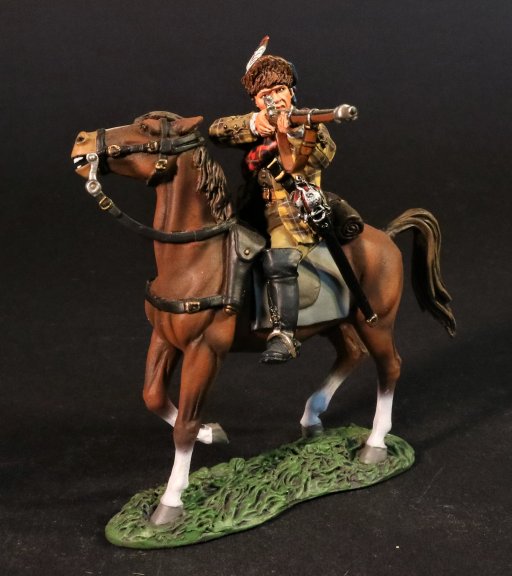
JRCAV-01
THE JACOBITE REBELLION 1745
THE JACOBITE ARMY,
BAGOT’S HUSSAR.
(2pcs)
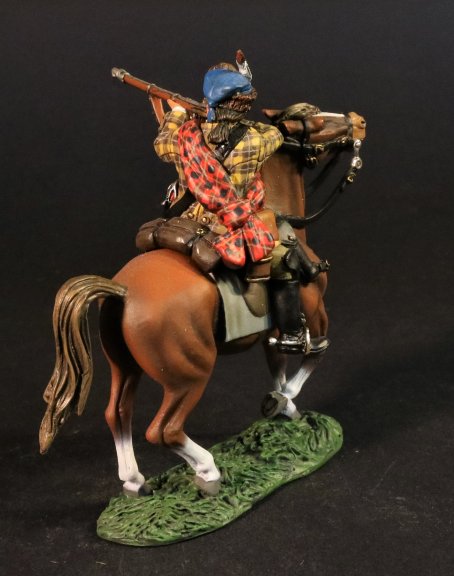
In keeping with the rest of the Highland army, most Jacobite cavalry were dressed in Highland clothes of some description.
The depiction of the Bagots’s Hussars in their distinctive tartan coats and fur caps is based on the Pencuik drawings, and James Ray’s description in his contemporary history of the Rebellion where he describes them as wearing “Plaid coats and huge fur caps”.
Most Jacobite cavalry were armed with a firelock, which reflected their primary role as a scout and skirmisher.
During the battle of Culloden, the Hussars were positioned on the left wing, but a volunteer from the Lifeguards named John Daniel mentions they were later moved to the centre, where they suffered heavy casualties.
As they only numbered 26 troopers at the start of the battle, it is believed that at least half their strength was lost. One of the casualties was the unit’s commanding officer, Major John Bagot, a regular officer in the French service, who was badly wounded.
THE EIGHTEENTH CENTURY COLLECTION
DRUMS ALONG THE MOHAWK
THE BATTLE OF ORISKANY, 1777.
THE 3rd NEW YORK REGIMENT
The 3[SUP]rd[/SUP] New York Regiment was authorized on May 25[SUP]th[/SUP] 1775 and organized from June 28[SUP]th[/SUP] to August 4[SUP]th[/SUP] from the counties of Ulster, Dutchess, Orange and Suffolk under the command of Colonel James Clinton for 5 months service in Canada. The enlistments of the first establishment ended on December 31[SUP]st[/SUP] 1775.
The second establishment of the Regiment was authorized on January 19[SUP]th[/SUP] 1776. And was raised a third time in December 1776 under the command of Peter Gansevoort.
The regiment saw action in the Invasion of Canada, New York Campaign and Fort Stanwix.
The regiment was merged into the 1[SUP]st[/SUP] New York Regiment on January 1[SUP]st[/SUP] 1781.
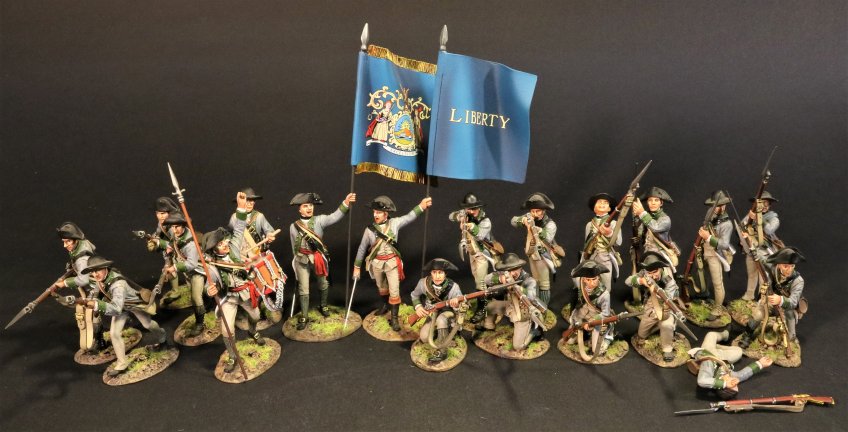
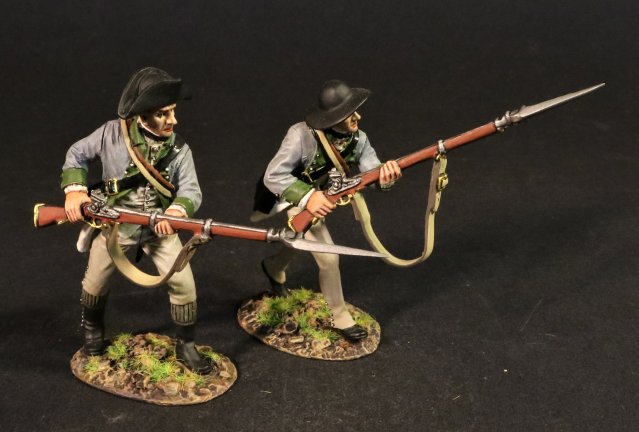
SNY3-11
DRUMS ALONG THE MOHAWK,
CONTINENTAL ARMY,
THE 3rd NEW YORK REGIMENT,
2 LINE INFANTRY.
(2pcs)
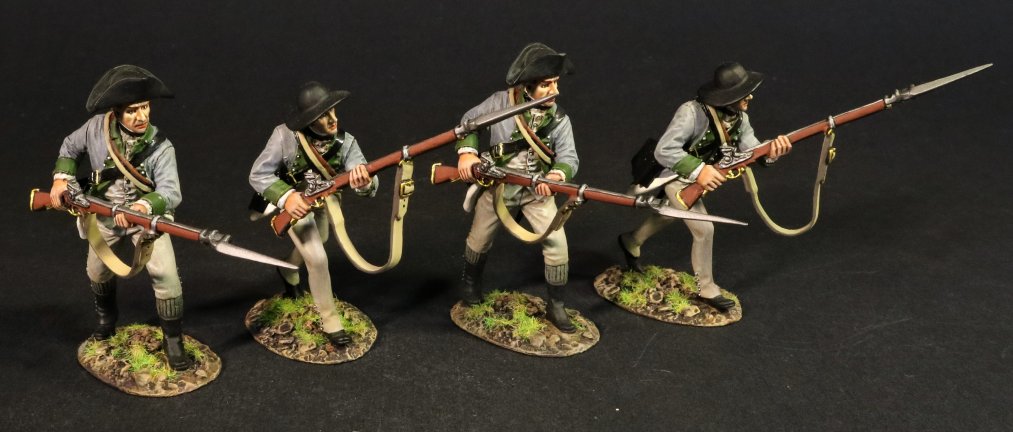
SNY3-11N
DRUMS ALONG THE MOHAWK,
CONTINENTAL ARMY,
THE 3rd NEW YORK REGIMENT,
4 LINE INFANTRY.
(4pcs)
At the Battle of Oriskany the British loyalists under Major Stephen Watts, wearing their coats inside out tried to penetrate the American lines by pretending to be reinforcements from the 3[SUP]rd[/SUP] New York Regiment at Fort Stanwix. They achieved this by reversing their coats, revealing their grey lining and green facings which were the same as the 3[SUP]rd[/SUP] New York.
It was Captain Gardenier of Visscher’s Regiment at the American rear which spotted the ruse when one of his men went out to greet these “friends” and was promptly captured. Gardenier, armed only with a spontoon and sword, rushed forward and killed his man’s captor. Desperate hand to hand fighting followed between the loyalists and the American militia, as Gardenier shouted “they are not our men – they are the enemy! Fire away!”.
Both sides withdrew to recover, as three cannon shots were heard in the distance. Herkimer and his men knew instantly what this meant, that the 3[SUP]rd[/SUP] New York at fort Stanwix had raided and sacked the loyalist camp.
Already demoralized by heavy losses, the threat to their possessions persuaded the remaining warriors to leave, and with insufficient numbers to fight on, Johnson also decided to withdraw.
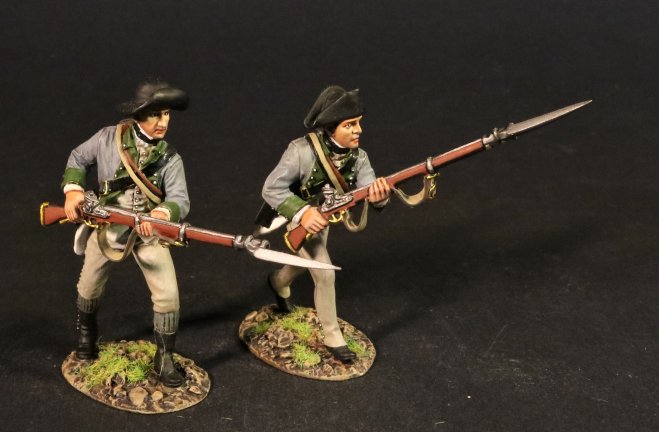
SNY3-12
DRUMS ALONG THE MOHAWK,
CONTINENTAL ARMY,
THE 3rd NEW YORK REGIMENT,
2 LINE INFANTRY.
(2pcs)
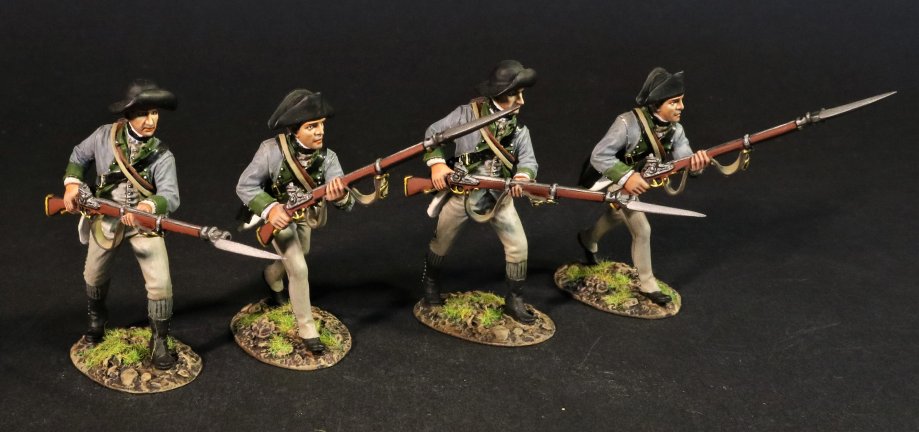
SNY3-12N
DRUMS ALONG THE MOHAWK,
CONTINENTAL ARMY,
THE 3rd NEW YORK REGIMENT,
4 LINE INFANTRY.
(4pcs)
The 3[SUP]rd[/SUP] New York Regiment figures will be suitable to be included as a loyalist force at the Battle of Oriskany.
In 1779, the 3rd NY Regiment received a gift from Col. Gansevoort in the form of a regimental flag. This flag, which was carried for the remainder of the war, later served as the basis for the present day New York State flag. On campaign, the regiment made up part of the troops committed to the various expeditions against British allied Six Nations settlements. In April 1779, the light infantry company returned to the Mohawk Valley as part of a detachment sent from Ft. Schuyler to destroy the principle Onondaga Indian villages. From August through September, the entire regiment was part of the Clinton-Sullivan expedition that destroyed the principle Cayuga and Seneca Indian villages in western New York. The regiment also participated in one major battle of the expedition at Newtown, which resulted in a major defeat for the Indians and the loyalist troops supporting them. In September, the 3rd NY once again returned to the Mohawk Valley, having been given the task of destroying the Mohawk village near Fort Hunter and retrieving the expedition's baggage. With the approach of winter, the regiment rejoined the main army under General Washington for the hard winter encampment of 1779-80 at Morristown, New Jersey.
Throughout 1780, the 3rd NY was engaged in garrison duties. Various detachments of the regiment were posted to the Mohawk Valley, the upper and lower Hudson Valley, and West Point. In December of 1780, the 3rd NY became part of the 1st NY Regiment, as the five New York regiments were consolidated into two for the remainder of the war. As part of the 1st NY, the men of the 3rd NY Regiment took part in the siege of Yorktown in October of 1781. The New York Light Infantry companies made up part of the force that successfully attacked Redoubt Number 10, which helped bring about the British surrender. After Yorktown, the New York troops went into winter quarters at Pomona, New Jersey.
In the spring of 1782, the two New York regiments went into final quarters at New Windsor, New York, as the war wound down. In June, many of the men were furloughed home; and in November 1783, with the coming of peace, the men of the old 3rd NY Regiment were honorably discharged and became citizens of the new United States of America.
**PLEASE CONTACT YOUR LOCAL DEALER FOR FURTHER INFORMATION**
THE JACOBITE REBELLION 1745
JACOBITE CAVALRY
It is argued that despite being depicted as horseless troopers standing forlornly in the rear at Culloden, the Jacobite cavalry were regarded when it came to scouting as superior to their regular opponents.
All of the Jacobite cavalry units remained mounted throughout the campaign, except for Kilmarnock’s and Lord Pitsligo’s who turned their horses over to the newly arrived Fitzjames Cavallerie in March 1746, and were then re-organized as a regiment of foot guards.
The cavalry, with the exception of the single troop of Hussars, were organized into two troops, and were over-officered to an even greater degree than the infantry.
BAGOT’S HUSSARS
A single troop of 50 men raised in Edingburgh by John Murray of Broughton and officered by a group of Lothian gentry, were designated as Hussars. It is unclear why they were designated hussars a role until then unknown in Britain.
Their clothing included a fur-trimmed hussar cap of obsolete French pattern. These caps were an obsolete style once worn by hussars in the French army, and were probably brought over from France, along with the Lifeguard blue coats.
As Murray of Broughton served on Charles’ staff, the hussars were led by Captain George Hamilton of Redhouse until his capture at Clifton.
Bagot originally an officer in French service recognized that the unit would be ineffective in open battle and instead trained them to operate as light cavalry in the continental manner, and earned the respect of Cumberland’s cavalry as a proficient reconnaissance unit.

JRCAV-01
THE JACOBITE REBELLION 1745
THE JACOBITE ARMY,
BAGOT’S HUSSAR.
(2pcs)

In keeping with the rest of the Highland army, most Jacobite cavalry were dressed in Highland clothes of some description.
The depiction of the Bagots’s Hussars in their distinctive tartan coats and fur caps is based on the Pencuik drawings, and James Ray’s description in his contemporary history of the Rebellion where he describes them as wearing “Plaid coats and huge fur caps”.
Most Jacobite cavalry were armed with a firelock, which reflected their primary role as a scout and skirmisher.
During the battle of Culloden, the Hussars were positioned on the left wing, but a volunteer from the Lifeguards named John Daniel mentions they were later moved to the centre, where they suffered heavy casualties.
As they only numbered 26 troopers at the start of the battle, it is believed that at least half their strength was lost. One of the casualties was the unit’s commanding officer, Major John Bagot, a regular officer in the French service, who was badly wounded.
THE EIGHTEENTH CENTURY COLLECTION
DRUMS ALONG THE MOHAWK
THE BATTLE OF ORISKANY, 1777.
THE 3rd NEW YORK REGIMENT
The 3[SUP]rd[/SUP] New York Regiment was authorized on May 25[SUP]th[/SUP] 1775 and organized from June 28[SUP]th[/SUP] to August 4[SUP]th[/SUP] from the counties of Ulster, Dutchess, Orange and Suffolk under the command of Colonel James Clinton for 5 months service in Canada. The enlistments of the first establishment ended on December 31[SUP]st[/SUP] 1775.
The second establishment of the Regiment was authorized on January 19[SUP]th[/SUP] 1776. And was raised a third time in December 1776 under the command of Peter Gansevoort.
The regiment saw action in the Invasion of Canada, New York Campaign and Fort Stanwix.
The regiment was merged into the 1[SUP]st[/SUP] New York Regiment on January 1[SUP]st[/SUP] 1781.


SNY3-11
DRUMS ALONG THE MOHAWK,
CONTINENTAL ARMY,
THE 3rd NEW YORK REGIMENT,
2 LINE INFANTRY.
(2pcs)

SNY3-11N
DRUMS ALONG THE MOHAWK,
CONTINENTAL ARMY,
THE 3rd NEW YORK REGIMENT,
4 LINE INFANTRY.
(4pcs)
At the Battle of Oriskany the British loyalists under Major Stephen Watts, wearing their coats inside out tried to penetrate the American lines by pretending to be reinforcements from the 3[SUP]rd[/SUP] New York Regiment at Fort Stanwix. They achieved this by reversing their coats, revealing their grey lining and green facings which were the same as the 3[SUP]rd[/SUP] New York.
It was Captain Gardenier of Visscher’s Regiment at the American rear which spotted the ruse when one of his men went out to greet these “friends” and was promptly captured. Gardenier, armed only with a spontoon and sword, rushed forward and killed his man’s captor. Desperate hand to hand fighting followed between the loyalists and the American militia, as Gardenier shouted “they are not our men – they are the enemy! Fire away!”.
Both sides withdrew to recover, as three cannon shots were heard in the distance. Herkimer and his men knew instantly what this meant, that the 3[SUP]rd[/SUP] New York at fort Stanwix had raided and sacked the loyalist camp.
Already demoralized by heavy losses, the threat to their possessions persuaded the remaining warriors to leave, and with insufficient numbers to fight on, Johnson also decided to withdraw.

SNY3-12
DRUMS ALONG THE MOHAWK,
CONTINENTAL ARMY,
THE 3rd NEW YORK REGIMENT,
2 LINE INFANTRY.
(2pcs)

SNY3-12N
DRUMS ALONG THE MOHAWK,
CONTINENTAL ARMY,
THE 3rd NEW YORK REGIMENT,
4 LINE INFANTRY.
(4pcs)
The 3[SUP]rd[/SUP] New York Regiment figures will be suitable to be included as a loyalist force at the Battle of Oriskany.
In 1779, the 3rd NY Regiment received a gift from Col. Gansevoort in the form of a regimental flag. This flag, which was carried for the remainder of the war, later served as the basis for the present day New York State flag. On campaign, the regiment made up part of the troops committed to the various expeditions against British allied Six Nations settlements. In April 1779, the light infantry company returned to the Mohawk Valley as part of a detachment sent from Ft. Schuyler to destroy the principle Onondaga Indian villages. From August through September, the entire regiment was part of the Clinton-Sullivan expedition that destroyed the principle Cayuga and Seneca Indian villages in western New York. The regiment also participated in one major battle of the expedition at Newtown, which resulted in a major defeat for the Indians and the loyalist troops supporting them. In September, the 3rd NY once again returned to the Mohawk Valley, having been given the task of destroying the Mohawk village near Fort Hunter and retrieving the expedition's baggage. With the approach of winter, the regiment rejoined the main army under General Washington for the hard winter encampment of 1779-80 at Morristown, New Jersey.
Throughout 1780, the 3rd NY was engaged in garrison duties. Various detachments of the regiment were posted to the Mohawk Valley, the upper and lower Hudson Valley, and West Point. In December of 1780, the 3rd NY became part of the 1st NY Regiment, as the five New York regiments were consolidated into two for the remainder of the war. As part of the 1st NY, the men of the 3rd NY Regiment took part in the siege of Yorktown in October of 1781. The New York Light Infantry companies made up part of the force that successfully attacked Redoubt Number 10, which helped bring about the British surrender. After Yorktown, the New York troops went into winter quarters at Pomona, New Jersey.
In the spring of 1782, the two New York regiments went into final quarters at New Windsor, New York, as the war wound down. In June, many of the men were furloughed home; and in November 1783, with the coming of peace, the men of the old 3rd NY Regiment were honorably discharged and became citizens of the new United States of America.
**PLEASE CONTACT YOUR LOCAL DEALER FOR FURTHER INFORMATION**

